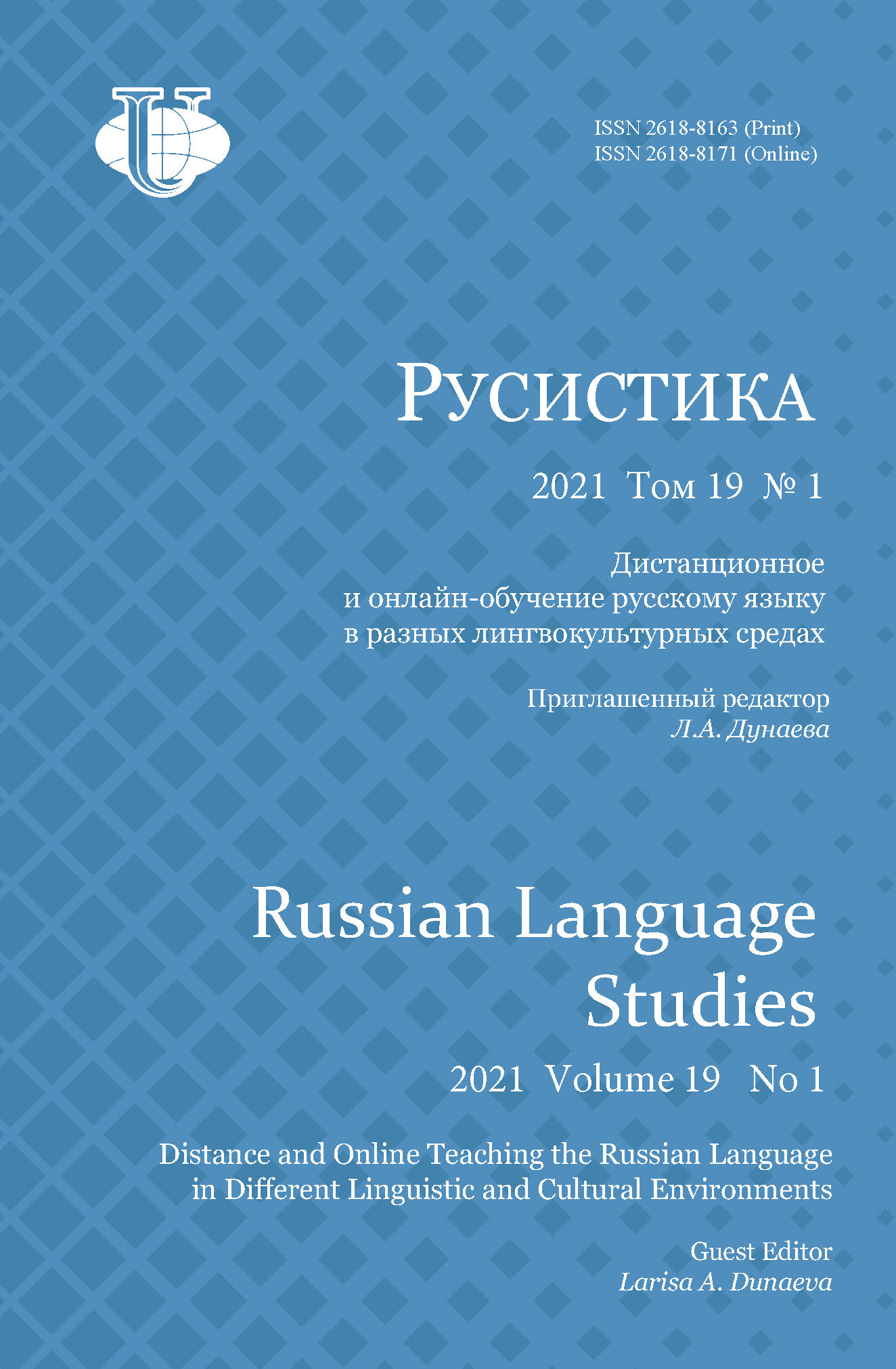Teaching Russian as a Foreign Language with the Use of LearningApps Service
- Authors: Ignatovitch T.V.1
-
Affiliations:
- Belarusian State University
- Issue: Vol 19, No 1 (2021): Distance and Online Teaching the Russian Language in Different Linguistic and Cultural Environments
- Pages: 51-65
- Section: Mediadidactics and electronic means of instruction
- URL: https://journals.rudn.ru/russian-language-studies/article/view/26130
- DOI: https://doi.org/10.22363/2618-8163-2021-19-1-51-65
- ID: 26130
Cite item
Full Text
Abstract
The article describes the experience of using applications of the LearningApps service in the practice of teaching Russian as a foreign language (hereinafter - RFL) to students of the Institute of International Education, Henan University of Science and Technology in the 2018-2020 academic years. The relevance of the topic is due to the lack of a comprehensive description of the potential of the LearningApps service simulators in traditional and distance teaching of foreigners. The purpose of the article is to show the possibilities of LearningApps service simulators as an accompanying electronic resource in teaching various aspects of RFL. The study of the service teaching potential was carried out using the analysis of scientific literature and the study of the service functionality, observation and generalization of pedagogical experience, conversations with students and teachers. In the course of the study, the positive and negative aspects of the resource under consideration were identified. Its advantages for a student are interactivity, individual trajectory of the student's performance, the possibility of receiving prompt advice and multiple execution, game form, availability of a large variety of task templates (more than 20). The advantages of the resource for a teacher are simplicity in learning, lack of linkage of exercises with a certain training platform, which allows including them in printed and electronic teaching aids, availability of ready-made exercises in the public database or possibility to make your own exercises based on them, the ability to use it for different methodological purposes: demonstration, search for information, formation of skills and abilities in different types of speech activity, the possibility of intensive learning of vocabulary, grammar, speaking, listening, control, conducting students’ individual work, depending on the level of language proficiency. The disadvantages include the impossibility of quick assessment using a point-rating system, the absence of the Cyrillic font in some templates, the absence of some templates in the database. The prospects for using the resource are associated with the need to develop distance learning of RFL.
Full Text
Figure 1. Example pattern exerciser “Quiz with choosing the correct variant”
Figure 2. Example pattern exerciser “Classification”
Figure 3. Example pattern exerciser “Let’s guess”
Figure 4. Example pattern exerciser “Sorting pictures”
Figure 5. Example pattern exerciser “Text input”
Figure 6. Example pattern exerciser “Audio and video content”
Table 1. Exerciser “People are different, but the country is one”
Theme | QR code and link | Pattern |
People are different, | https://learningapps.org/display?v=puwb2h2pn20 | Audio and video content |
Figure 7. Example pattern exerciser “Net of applications”
Table 2. Exerciser “Time designation”
Theme | QR code and link | Pattern |
Time designation | Net of applications |
About the authors
Tatiana V. Ignatovitch
Belarusian State University
Author for correspondence.
Email: tavlig@mail.ru
Ph.D., Associate Professor of the Department of Rhetoric and Methods of Teaching Language and Literature
4 Nezavisimosti Ave, Minsk, 220050, Republic of BelarusReferences
- Avilova, I.A., & Strukova, V.G. (2016). Using the e-Learning educational platform for developing e-learning resources. Technical and Mathematical Sciences: Youth Scientific Forum: Electronic Collection of Articles. (pp. 8–13). Moscow. (In Russ.)
- Ignatovitch, T.V. (2019). Interactive applications in the RCT course: experience in the use of. Distance Learning – the Educational Environment of the XXI Century: Materials of the XI International Scientific and Methodological Conference. (pp. 120–121). Minsk, BSUIR Publ. (In Russ.)
- Ignatovitch, T.V. (2019). Using interactive applications in the RCT course (elementary and basic levels). Sino-Belarusian Language, Literary and Cultural Relations: History and Modernity: Materials of the International Scientific Conference (pp. 257–262). Minsk: BSU Publ. (In Russ.)
- Khutorskoi, A.V. (2000). Features of the development of distance learning in Russian schools. Researched in Russia, (2), 5–8. (In Russ.) Retrieved September 17, 2020, from http://zhurnal.ape.relarn.ru/articles/2000/002.pdf.
- Khutorskoi, A.V. (2000, March 10). Internet pedagogical practice overtakes theory. Eidos. Retrieved October 10, 2020, from http://eidos.ru/journal/2000/0310-01.htm.
- LearningApps.org. Retrieved October 11, 2020, from https://learningapps.org/about.php.
- Malyavin, V.V. (2007). China managed. Good old management. Moscow, Europe Publ. (In Russ.)
- Moiseeva, M.V. (Ed.). (2004). Online learning: Technologies of pedagogical design. Moscow, Kameron Publ. (In Russ.)
- Murina, L.A., Ignatovich, T.V., & Zhadeiko, Zh.F. (2018). Russian language: Textbook for the 8th grade of institutions of general secondary education with Belarusian and Russian language of instruction. Minsk, NIO Publ. (In Russ.)
- Murina, L.A., Ignatovich, T.V., & Zhadeiko, Zh.F. (2019). Russian language: Textbook for the 5th grade of institutions of general secondary education with Belarusian and Russian language of instruction (part 1). Minsk, NIO Publ. (In Russ.)
- Murina, L.A., Ignatovich, T.V., & Zhadeiko, Zh.F. (2019). Russian language: Textbook for the 5th grade of institutions of general secondary education with Belarusian and Russian language of instruction (part 2). Minsk, NIO Publ. (In Russ.)
- Murina, L.A., Ignatovich, T.V., & Zhadeiko, Zh.F. (2020). Russian language: Textbook for the 6th grade of institutions of general secondary education with Belarusian and Russian languages of instruction. Minskm, National Institute of Education. (In Russ.)
- Polat, E.S. (2004). Theory and practice of distance learning: A textbook for students of higher pedagogical educational institutions. Moscow, Akademiya Publ. (In Russ.)
- Valverde-Berrocoso, J., et al. (2020). Trends in educational research about e-learning: A systematic literature review (2009–2018). Sustainability, 12, 51–53.
- Wei, Wei. (2014). National-oriented Russian-language text: Linguoculturological means of creating an image of China (Candidate dissertation, Minsk). (In Russ.)
- Vladimirova, L.P. (2014). Distance learning of foreign languages: Specifics and prospects. Foreign Languages at School, 2(29), 68–72. (In Russ.)
- Zankova, A.A. (2019). Learning Russian as a foreign language in an online environment: Opportunities and specifics. World of Science, Culture, and Education, 2(75), 28–29. (In Russ.)
Supplementary files























